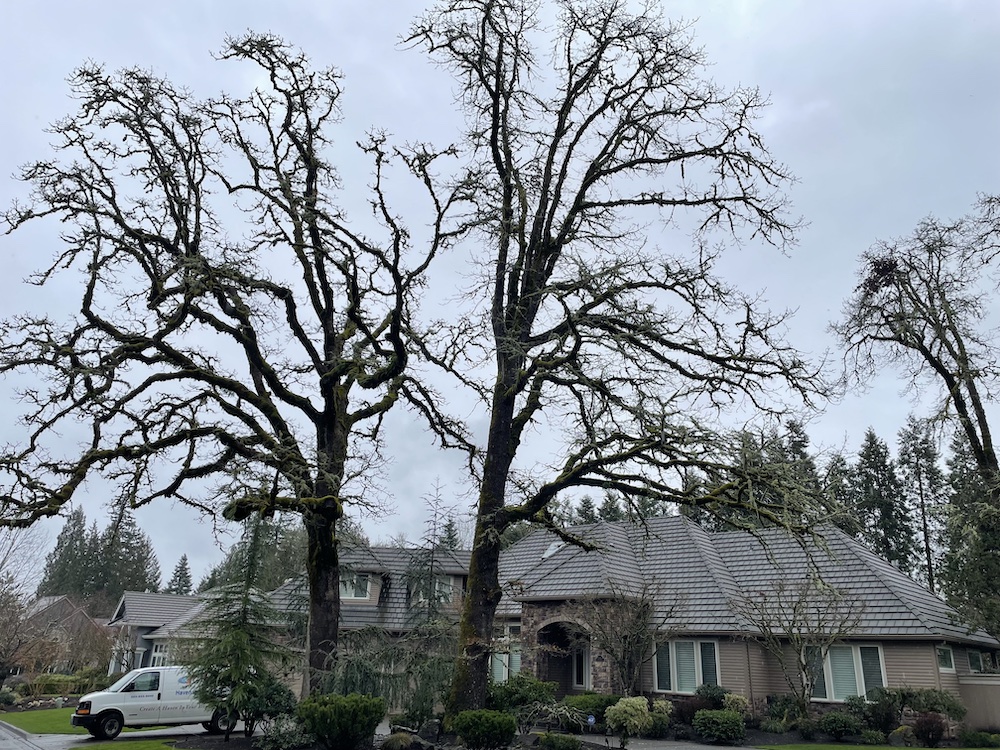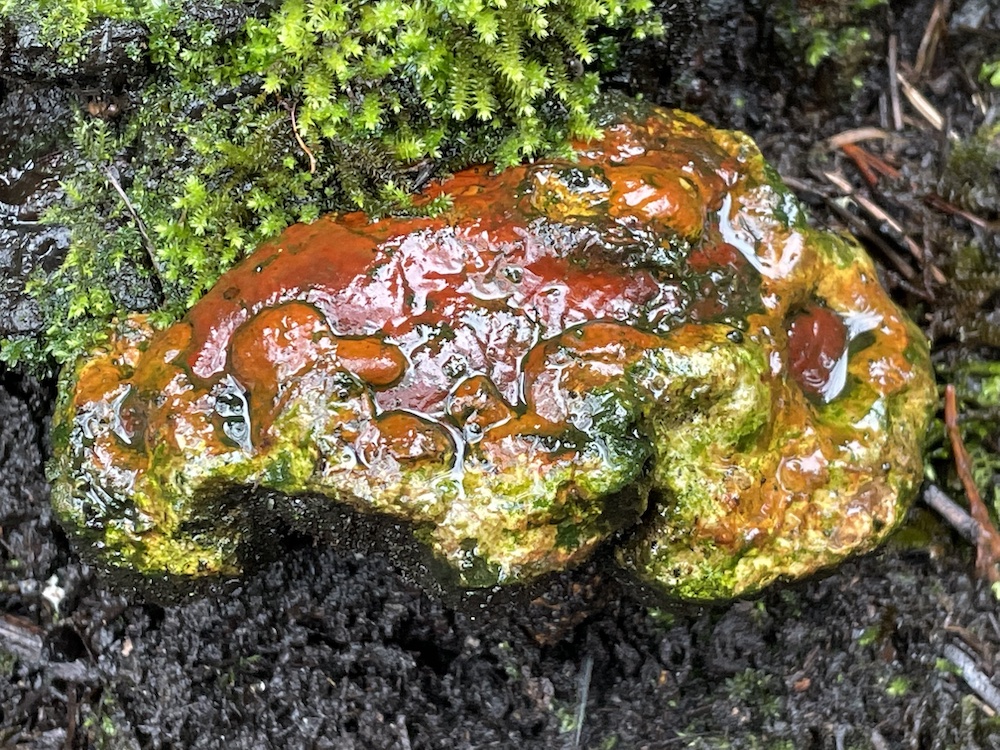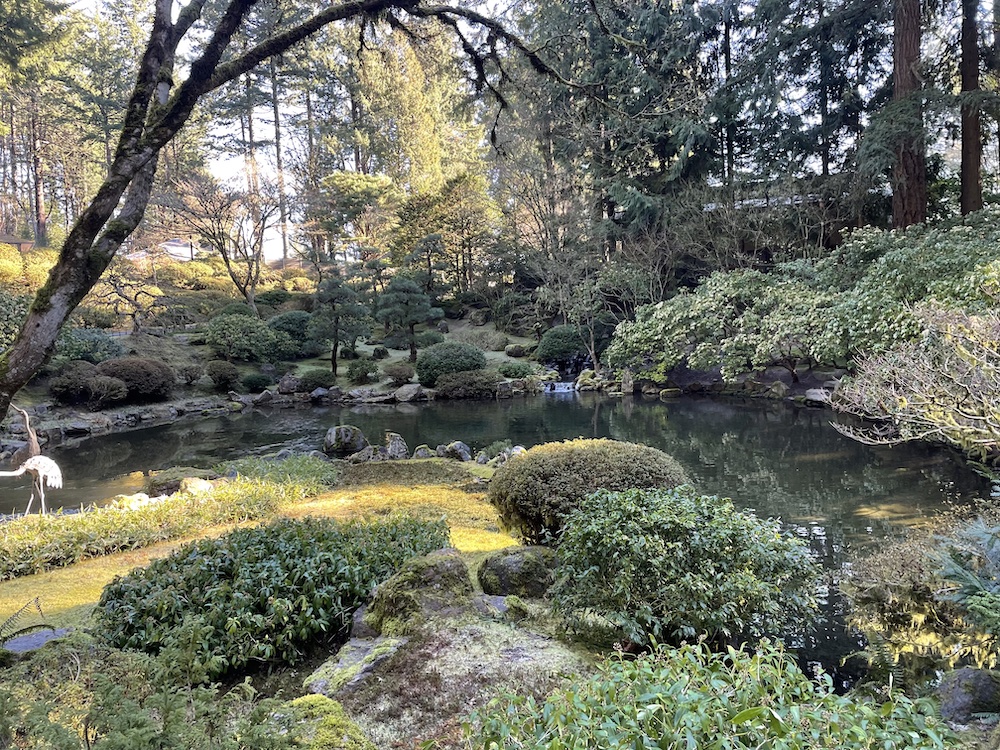
This guide is tailored for the western valleys of Oregon and Washington.
YOU can help to make the world a better, a more friendly, loving and beautiful place by being a good steward of the spot on this earth, your garden, that you have been given the privilege of borrowing for a time. It is our hope that the following to-do list will help you to do just that.
Nathan, the Treevangelist, that is, the preacher of the good news about the beauty and benefit of trees, urges you to treat your spot on this planet like your own personal biblical Garden of Eden. May it become your personal paradise and refuge from this hectic and stressful world. The care of your garden is your divinely mandated responsibility. Your trees, shrubs, flowers and the wildlife in your yard depend on your vigilant and loving care, and they will pay you back as they express their smiling appreciation to you and yours by radiating their love, joy and beauty bursting forth with vibrant and verdant life. Below is a to-do list to help fulfill this godly mission.
It seems to this Pacific Northwest native that this winter has been more normal in terms of rainfall amounts and temperatures than several of our previous years. The rain, so far, has been regular, which is a welcome relief from the alarmingly irregular rain patterns and drought conditions of the past few years. So we thank Heaven for this, for it is the rain that keeps our northwest region the luscious garden and the envy of outsiders for which it is well-known. On a personal note, I have traveled to some 22 countries on four continents and half of the U.S. states including Alaska and Hawaii. I also spent a year living in the mountains of Switzerland at the foot of its famous Alps. So I have seen a lot of this earth’s natural splendor, yet no place that I have seen to date has more natural beauty and diversity, in my opinion, than our Pacific Northwest. So let’s all do our part to keep it this way!
While you’re at it, take a few moments and scroll back through this same Good News Tree Service, Inc. blog and check out the archives for any tree and plant care articles that you may have missed. Also check out our YouTube channel at https://www.youtube.com/channel/UCvcu2lL9NpgoXQtUFYyQShw, our Facebook page at https://www.facebook.com/GoodNewsTreeService/ and our main website at https://goodnewstree.com. Please enjoy!
Readers’ suggestions on how to improve this list are gladly solicited. If you, the reader, have any suggestions for additions to this month’s list, please put them in the comments section of this article, and I will add them to the list. Thank you in advance! — Nathan
Tree and Shrub Care

- Fruit tree pruning. Prune your fruit trees for fruit production. You can also prune grapes, cane and trailing berries once the threat of major frost is past.
- Plant fruit trees. At this time of the year, bare root fruit trees can be purchased inexpensively at your local garden center. It is imperative to plant them while they are still in their dormant state and before their buds start to swell just before bloom time.
- Plant trees and shrubs. Now is an excellent time to plant all kinds of trees and shrubs in the garden, while the weather is cool and the plants are still dormant. This is also a good time to reduce the height of overgrown fruit trees, since they are likely to produce fewer water sprouts now then when pruned in the spring.
- Severe pruning of some ornamental shrubs. Now is an excellent time to do major pruning (even back to bare stocks) of certain overgrown evergreen shrubs before they start their new growth in the next month or so. Shrubs that can be pruned back severely include rhododendron (or rhody), camellia, andromeda or lily of the valley shrub, Japanese holly, laurel and photinia to name a few. Not all shrubs can take such severe pruning, so know the growth habits of your plant before doing so. When you prune, make sure that you cut back to a bud point or a branch union. Do not cut internodially or between buds points or leaf whirls.
- Mulch. Apply two to three inches of mulch around all trees and ornamental shrubs. This helps to fertilize the plants and feed the soil, and also protects them against weed growth and loss of water when the warmer weather returns.
- Pine tree pruning. Prune coast or shore pines (Pinus contorta) and Scotch or Scots pines (Pinus sylvestris). These two pines are especially susceptible to the sequoia pitch moth whose larvae burrow into the tree trunks during the growing season (April through September) causing the trees to exude large amounts of unsightly pitch globules. While this seldom kills the tree, the bleeding of sap is not good for the overall health and vigor of the tree. It is advisable, therefore, not to prune these pine trees during the growing season, since the pruning cuts attract the moth, which then lays eggs on the tree, which hatch into tree-burrowing larvae. Pruning should be done on your pines from November to March.
- Plant or transplant trees and shrubs. Winter is a good time to plant or transplant ornamental trees and shrubs. Cooler weather means less transplant shock to the plants, and over the winter and spring, they will have time to begin to acclimate to their new environment before the stress of the next summer season occurs.
- Pruning of large trees. Winter is a great time to do aesthetic and structural pruning of deciduous trees and shrubs, since the structure or architecture of the plant is clearly visible making aesthetic pruning easier than when plants are foliated. Structural defects, which can cause tree failure, are more easily spotted as well. Also remove of dead wood, and pruning to reduce hazards. If you’re not sure what to do, or how to do it, call Good News Tree Service, Inc. for a consultation, pruning lessons or to have them do the pruning for you.
- Reparative pruning. Repair winter damaged to trees and shrubs.
- Roses. The best time to prune roses is after the threat of major frost is past.
- Tree and shrub removal and stump grinding can be done all year long.
- Trees. Have an ISA Certified Arborist with an ISA Tree Risk Assessment Qualification (like Good News Tree Service, Inc.) inspect your large trees for the potential of failure due to weak root systems and defects in trunks and branches. This is best done when the leaves are off the trees.
Plant Health Care

Good News Tree Service, Inc. provides full plant health care services as listed below.
- Apple scab on ornamental crabapple and fruiting apple trees. The first visible symptoms occur on leaves in spring as pale, yellowish, water-soaked spots the size of a pinhead. These enlarge, becoming darker and smoky in appearance, later taking on an olive shade and ultimately a brownish black color. Spots may be any shape but are frequently circular. Young infections often show a radiating spread of fungal tissue through the leaf, and such areas later appear as irregular, brown-colored infections. Diseased leaves can be curled and distorted and often drop early. This fungal disease can also move into the fruit to produce a scabby effect, hence the name “apple scab.” Several fungicidal sprays are required to control this disease just prior to flowering and after flowering.
- Arborvitae Berckmann’s Blight (Platycladus orientalis). Spray in the fall (late Sept. and early Oct., and again in early Nov. Spray again in early spring (Feb to Mar) if disease is severe.
- Cherry Tree Brown Rot Blossom Blight (Monilinia fructicola). Make 3 foliar applications starting at bud break and at 14 day intervals.
- Coryneum Blight (Shot Hole Fungus) or Cherry & Plum Leaf Spot. This leaf blight affects ornamental and flowering cherry, plum and prune trees. Apply fungicide in the spring at flower petals fall, shuck fall and two weeks later.
- Crabapple Leaf Blight. Apply fungicide as the leaf clusters are just opening up and make several more applications subsequently as per label directions.
- Deep Root Fertilization. Deep root fertilize your trees and shrubs just prior to or as new leaves begin to emerge. Apply when soils are not super-saturated with rain, so that the fertilizer isn’t washed away from plants’ roots after applications is made.
- Dormant Spraying of Fruit Trees. Apply dormant sprays against insects and fungi.
- Lawns. Fertilize yellowing lawns.
- Leaf Blights. Spray trees and shrubs for fungal leaf diseases (e.g. powdery mildew, leaf blights, dogwood anthracnose, needle blights, etc.).
- Magnolia Bacterial Blight. Apply one spray in fall and twice in spring near budbreak.
- Monitor trees and shrubs for insect pests. When piercing and sucking plant pests (e.g. aphids, lacebugs, scales, weevils, mites, etc.) hatch varies each year depending on when the warmer weather begins. Usually, hatching of plant pests begins from early to late April. When consistent warm weather begins to occur, start monitoring plants for insect nymphs and adults. If necessary, plan a course of action to treat your trees and shrubs against these pests.
- Piercing-Sucking Insects. Begin applying systemic insecticides against piercing sucking insects (aphids, lacebugs, scales, weevils, etc.) via soil injections (one treatment gives season-long control).
- Photinia leaf spot. Spray a fungicide early in February of four applications at two week intervals afterwards. Early spray is key to controlling this fungus.
- Powdery Mildew. Apply a fungicides as soon as symptoms appear. Best efficacy if used before symptoms appear. Use fungicide at seven to fourteen day intervals, or more often if conditions warrant it. If a plant is known to have had powdery mildew previously, apply as buds start to open.
- Tent Caterpillar. Apply systemic pesticide for season-long control.
- Verticillium Wilt Fungal Disease. Apply a soil in the fall and spring.
Elsewhere in the Garden

- Ferns. Ferns are popular ornamental plant that grow natively in the wilds of the Pacific Northwest. They require minimal care and thrive in shaded areas. To keep ferns looking beautiful throughout the coming season, a little manicuring is necessary. This involves cutting off last year’s fronds from ferns as new fiddleheads begin to emerge.
- Slug control. Put slug bait around winter flowers. Though the weather may be cold, slugs are still active.
- Clean up. Rake and dispose of ornamental tree leaves, or better yet, compost them and then spread the decomposed leaves back onto your shrub beds as a mulch next year.
- Mulch all of your shrub beds. Put a two to three inches of mulch (e.g. bark dust, garden compost or wood chips) around perennials and other plants that might be sensitive to subfreezing weather. Also, spread a fresh layer of mulch (e.g. bark dust, garden compost or wood chips) on all the bare dirt areas in your yard to prevent soil compaction from rains, to prevent weed growth and to enrich and help to condition your heavy clay soils.
- English ivy control. Though a decorative evergreen ground cover and climbing vine, English ivy is considered an invasive species, since it spread so rapidly and birds disperse its seeds everywhere. It will soon take over your yard and garden if not contained. Even worse, it grows up into trees, and even though it is not parasitic in that it takes nutrients from its host tree, it can eventually choke smother a tree foliage depriving the leaves of life-giving sunlight. The loss of foliage can stress and even eventually kill a trees. This is why it is imperative to cut ivy away from the base of your trees. The ivy climbing up into a tree can be killed simply by cutting through its stalks at the base of the tree. This can be done any time of the year.
- Feed the birds. Dutifully maintain your bird feeders. As winter comes, birds have a harder time finding food. This includes both seed and suet feeders. During dry spells, keep your bird bath watering hold full of fresh water. Caring for the local wild birds brings life and excitement to your backyard by turning it into a bird-friendly sanctuary. The birds will thank you for your generosity by providing you with hours of entertainment, and by eating insect pests that harm your ornamental trees and shrubs. Remember to feed your local humming birds that overwinter in our region. If possible, fill your humming bird feeders with a syrup that contains only 100 percent sugar (e.g. sucrose or dextrose) minus any artificial sweeteners, red dyes and other chemicals. Your birds will be healthier for it. You can find excellent bird care products and advice from knowledgeable and caring professionals at your local Backyard Bird Shop.
Care of Roses
- Prune roses. Mid to late-February or early March (or after the threat of hard frosts have passed is the time to prune roses for health and bloom potential. Remove dead, weak and spindly canes. Leave only the strongest and healthiest canes that are equally spread apart thus giving them good air circulation to reduce the potential spread of fungal pathogens that cause leaf diseases. An open spacing pattern of the canes also provides ample room for the blooms to grow without crowding each other. Make pruning cuts slightly above an outward-facing bud. Endeavor to prune rose bushes into an upward and outward vase-shaped form.
- Late winter-early spring. Now is the time to plant roses. Plant them in full sun. Roses don’t do well in shade and need at least six hours of sun per day especially in the summer. Morning sun is preferable to dry off the dew. Add plenty of mulch, manure or other soil amendment into the soil when planting. Choose pest and disease resistant rose varieties for best, long term results.
Lawn Care March Through May
- Feed the wild birds. Attracting wild birds to your garden is an excellent way to naturally control harmful insects. Allow wild birds such as starlings to peck at your grass as they are feeding on insects that are harmful to your lawn.
- Irrigation systems. Check your irrigation system well before the warm weather starts to ensure that there are no broken pipes, faulty sprinkler heads or broken risers. Check sprinkler heads for adequate coverage and adjust or replace as necessary. Check your timer to make sure it is functioning so that expensive water wastage does not occur. Have your irrigation backflow prevention device tested. In some cities, this a yearly requirement.
- Get your mower ready. Perform mower maintenance. Take your mower into repair shop to perform annual engine maintenance and blade sharpening. Do it early in the season when the repair shops are not busy and to avoid the spring rush, so that you will not be delayed in mowing your grass in the spring.
- Dethatch your lawn. Once your lawn has dried out and it is not excessively wet—usually in April or May—dethatch your lawn of old roots and stems. Rake and remove the thatch. Lawn dethatchers can be rented or your gardener can perform this service.
- Aerate compacted soil. Lawn soil becomes compacted due to human and pet traffic as well as rainfall thus hindering water and fertilizer penetration and the growth of grass roots. This is why it is wise to aerate your lawn occasionally—preferably annually—for the best looking and most healthy lawn. Lawn aerators can be rented or your gardener can perform this service.
- Remove perennial weeds. Once the grass starts to grow and on a dry day, spot treat weeds with an herbicide. Read and follow all label directions including wearing the recommended personal protection equipment (or PPE) when applying chemicals herbicides. At any time of the year, you can dig out the weeds by hand.

I took the following photos in a recent trip to the world-famous Portland Japanese Gardens where we take field trips to learn about ornamental shrub pruning styles and techniques.




